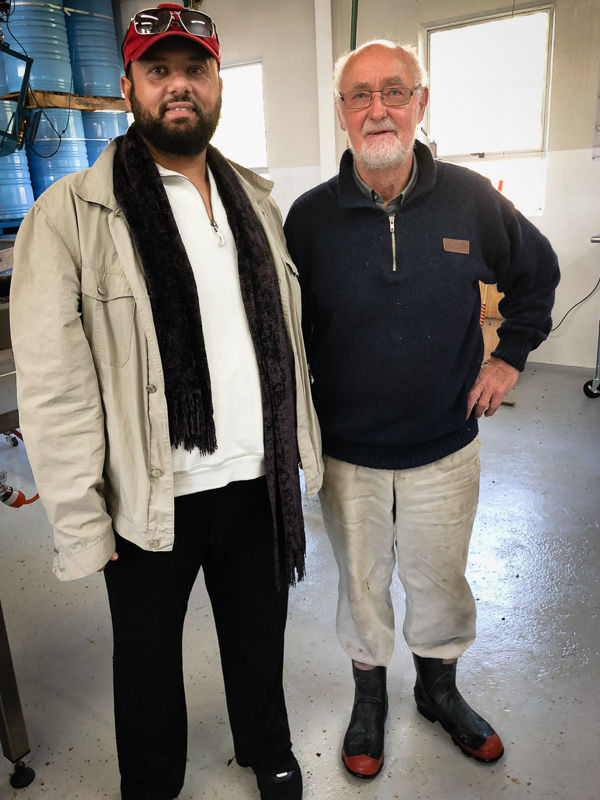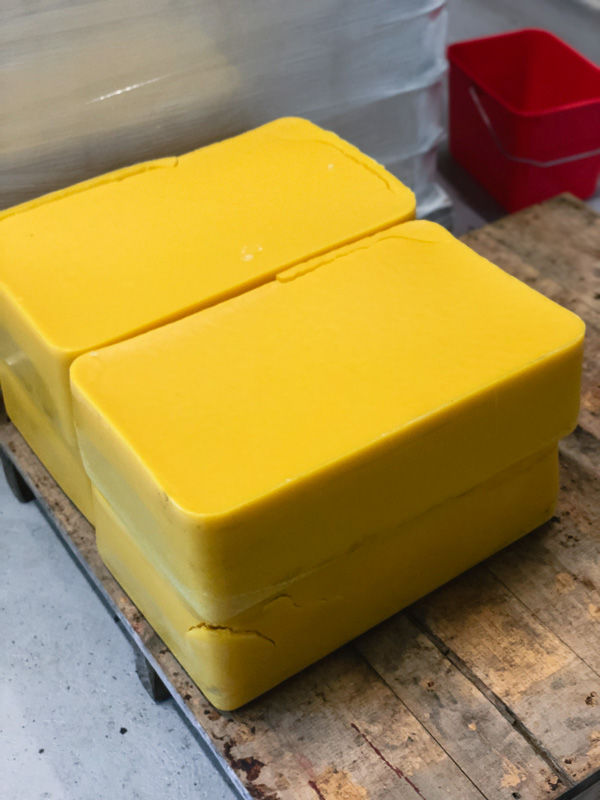هل تساءلت يومًا كيف ينتقل العسل السائل من قرص العسل إلى البرطمان دون احتواءه على شمع؟ هناك عدة طرق (بما في ذلك بعض الطرق المروعة حقًا التي تدمر النحل في إنتاج العسل التجاري على نطاق واسع). في زيارة إلى جزيرة الجنوب بنيوزيلندا لرؤية توم دنبار الذي يزود بلقيس بالعسل الخام الرائع من في High Peak Estate ، عرّفني جون سايم. قمت بجولة لمقابلة جون لأكتشف كيف طور طريقة مبتكرة لاستخراج كميات كبيرة من العسل مع الحفاظ على المنتج النهائي في حالة مثالية. إليكم قصة جون، وما تعلمته على طول الطريق، ولماذا يعد ذلك مهمًا للغاية لإنتاج عسل خام عالي الجودة.
يقع الموطن الأصلي لشركة Syme Apiaries في بلدة Stavely، بالقرب من Ashburton، حيث التقيت بـ John Syme، وهو مربي نحل ومهندس، والذي أخذني في جولة حول منزل العسل الخاص به وعرّفني على اختراعه.
يفتخر جون باختراعه لآلة استخلاص العسل الخام "رولز رويس"، كما يسميها، ويؤكد أنها الوحيدة من نوعها في العالم. وهذا يعني الكثير لأنه اخترعها منذ ما يقرب من خمسين عامًا.
ثلاثة أجيال من النحالين
لقد عمل جون في تربية النحل لمدة 77 عامًا، أي طوال حياته تقريبًا، وهو الجيل الثالث من عائلة سايمز الذي يربي النحل. كان والده وجده من قبله من مربي النحل الذين يزرعون أراضي الأدغال على ارتفاع 1400 قدم فوق مستوى سطح البحر. تعلم جون الكثير من والده وفي عام 1968 استلهم فكرة اختراع آلة لاستخراج العسل تفصل العسل الخام عن شمع العسل وتستخرج العسل الخام أيضًا. استغرق الأمر من جون ثلاث سنوات لتطويره واعترف باختبار النماذج الأولية المبكرة في "غسالة زوجتي". ثم حصل على براءة اختراع لحقوق اختراعه. تنتج قوة هذه الآلة 10 أطنان من العسل الخام يوميًا، وهذا كثير جدًا من العسل!
لماذا يتم فصل الشمع عن العسل الخام
يفرز النحل شمع العسل لصنع أقراص العسل التي تحمل العسل وتحميه في الصواني داخل الخلية. يختلط الشمع بالبروبوليس وحبوب اللقاح مما يعطيه لونًا أصفر. ولكي يفرز النحل الشمع، يجب أن تكون الخلية عند درجة حرارة تتراوح بين 33 درجة مئوية و36 درجة مئوية. وللحفاظ على القيمة الغذائية والخصائص العلاجية للعسل الخام، يجب ألا يتم تسخينه فوق درجة الحرارة الطبيعية في الخلية.
شمع العسل صالح للأكل ولكن قيمته الغذائية قليلة جدًا ولا طعم له. الغرض منه هو حماية العسل؛ كتاب بعنوان إنتاج شمع العسل، الحصاد، المعالجة والمنتجات يقترح استخدام 1 كجم من شمع العسل لتخزين 22 كجم من العسل. منذ العصور المبكرة، أدرك الإنسان أن شمع العسل الطبيعي له العديد من الاستخدامات العملية وكانت شموع شمع العسل مصدرًا أساسيًا للضوء لعدة قرون. يجب فصل الشمع حتى نتمكن من الاستمتاع بنقاء الجائزة (العسل الخام) وقد تبنى النحالون مجموعة متنوعة من التقنيات للقيام بذلك.
يتيح اختراع جون إنتاج العسل على نطاق واسع دون المساس بالجودة والصفات الخاصة للعسل الخام.
- رياض حامد من بلقيس وجون سايم
- شمع العسل المستخرج من قرص العسل
كيف يعمل اختراع جون سايم لاستخراج العسل
يقوم جون بإحضار الإطارات، كاملةً مع أقراص العسل، من الخلايا ويتم وضعها في الآلة التي تشبه الأسطوانة الكبيرة. يمكن لهذه الأسطوانة استيعاب ما يصل إلى 100 إطار. للحصول على فكرة عن الحجم، يمكنك مقارنة هذه الآلة بسعة 32 إطارًا التي استخدمها بيتر من A1 Honey في منشوري حول تربية النحل في الفناء الخلفي في كيب الغربية
تُكدس إطارات جون بإحكام معًا في الأسطوانة، ثم، مع زيادة السرعة بخمس خطوات، تُدور الإطارات لمدة 3 دقائق حتى تتوقف الآلة تلقائيًا. هذا هو الوقت الذي تستغرقه. تُزال الإطارات ويتم ضخ العسل الخام والشمع من الأغطية (الطبقة الرقيقة من الشمع المستخدمة لتغطية قرون العسل أو الخلايا) مرة أخرى في الآلة للفصل. بعد بضع دقائق، يدور العسل الخام إلى جوانب الأسطوانة مما يسمح للعسل الخام النقي الجميل بالتدفق إلى حوض جاهز للبرطمان.
بصفتي مشتريًا للعسل الخام، فأنا بحاجة إلى معرفة أن الموردين الذين ينتجون كميات كبيرة من العسل الخام يستخدمون طرقًا فعّالة دون المساومة على الجودة. ويحقق جون وأجهزته هذا من خلال:
- استخلاص العسل الخام دون تسخين وبالتالي الحفاظ على الفعالية والجودة، فيكون خامًا حقًا.
- لا تلمس يد الإنسان العسل الخام في أي خطوة من خطوات العملية (للنظافة).
الجيل القادم من مربي النحل
هذا ليس اختراع جون الوحيد. فهو أول من وجد في العالم طريقة لاستخدام نظام هيدروليكي لرفع خلايا النحل (مع النحل سليمة) على المنصات. وهذا يعني أنها لن تتعرض للمس من قبل البشر بشكل مباشر، وهو ما لا يؤثر على النحل. ومن خلال تقنية الشعاع والضغط على زر، يمكن لرجلين وشاحنتين نقل 1000 خلية نحل يوميًا، مما يوفر الوقت والجهد والتكلفة.
سألت جون عن رأيه في التحدي الأكبر الذي تواجهه الصناعة اليوم، وهو يعتقد أنه يتمثل في الافتقار إلى الحوافز والتدريب للشباب. إن التسعير العادل هو إحدى الطرق لجلب جيل أصغر سنًا إلى الصناعة، ولكن أيضًا تقديم التدريب الصحيح من قبل مربي النحل ذوي الخبرة الذين لديهم سنوات من الخبرة لمعرفة كيفية عمل العمليات بالضبط. لقد مروا بالتجارب والمحن ويمكنهم توجيه الشباب أو حتى تسريعهم حتى لا يضطروا إلى ارتكاب نفس الأخطاء والمرور بالمصاعب التي تحملها الجيل السابق.
عند الحصول على العسل الخام لبلقيس، أبحث عن المنتجين الذين يجلبون لنا العسل الخام الجميل من الخلية دون تلاعب. أريد العمل مع أشخاص ملتزمين بصحة النحل وجودة العسل الخام ولديهم ارتباط حقيقي بالأرض. لقد وجدت ذلك مع جون.
أربع حقائق عن شمع العسل قد تفاجئك
- يتم إنتاج شمع العسل عن طريق ثماني غدد موجودة في بطن النحلة العاملة.
- يعتبر شمع العسل هو الغذاء الرئيسي ليرقات عثة الشمع.
- كان يتم استخدام شمع العسل كشكل قديم لحشو الأسنان.
- يتم استخدام شمع العسل في شمع الشارب للحفاظ على "هراوة الشعيرات" ناعمة.
اترك لي تعليقًا إذا كنت تريد معرفة المزيد عن هذا الاختراع أو أي شيء آخر حول كيفية قيام النحالين بحصاد العسل الخام من الخلية.











